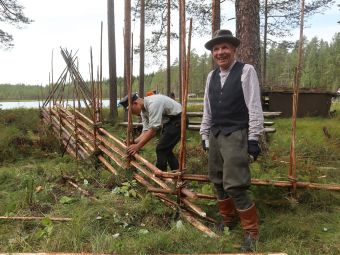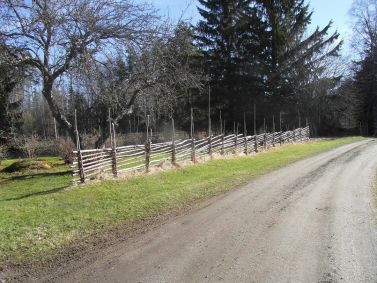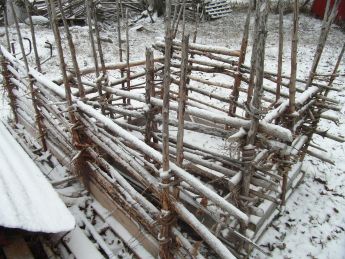Construction of a roundpole fence
| Construction of a roundpole fence | ||||
|---|---|---|---|---|
| In the national inventory | ||||
|
Practitioners and people who know the tradition well
At the beginning of the 20th century, the borders of a Southern Savonian farms were still bordered by many traditional fences.
Yards, especially vegetable gardens, were fenced with roundpole fences, while stone and split-rail fences bordered the fields and clearing areas. Even cattle lanes were fenced on both sides. The "short-run" pole fence or point fence had stakes of the same length that slanted from the ground up to the back of the fence. Such a fence was durable if the stakes were made from split young spruces or junipers. Singeing the lower ends of the stakes increased their lifespan.
Traditional pole fences have been built all over Finland. Pole fences have been a part of the Finnish rural landscape for centuries. Building methods and names for pole fences can vary by region. However, more detailed information about fences and their structures only dates back to the 18th century. Fences were constructed for various purposes, including trapping wild animals and demarcating and protecting cultivation and residential areas from wildlife, neighbors, and thieves. Even in the 2020s, pole fences are still made to fence in livestock and other domestic animals. Nowadays, electric wire is often used alongside pole fences in animal enclosures, which can be seen as an adaptation of tradition to the development of the surrounding society. Pole fences are still used as boundary fences for residential and vacation properties. There can be pole fences along the field edge for several kilometers.
As far as is known, pole fence construction is not taught in any educational institution in Finland. Those skilled in the technique are private individuals who are enthusiasts of the tradition. Currently, there are only a few of them in Finland.
One of the skilled practitioners of the traditional pole fence-making tradition is sheep farmer Matti Partio from Ristiina in Mikkeli, who provides demonstrations at various events in the summer-time. He has appeared at events such as Vanha Savotta in Rautjärvi, Pälkäne, Jokipelto Tractor and Agricultural Museum in Kuortti, Rauta ja Petrooli- event in Riihimäki, and Tupala’s Talomuseo's Konepäivät- event in Asikkala.
The tradition is maintained through fence-building events organized by institutions such as Metsähallitus, Rural Women’s Advisory Organization, local heritage associations, nature conservation organizations, and other associations

Practising of the tradition
A pole fence is constructed with upright stakes placed at regular intervals in the ground and horizontal stakes are positioned diagonally to form the wall between them. In some regions, it is customary for the horizontal stakes to be slanted strongly upward, while in other areas, they are nearly horizontal. Willow branches or twigs are twisted around the pair of stakes and support stakes are used for fastening and bracing. The necessary tools for this work include an iron bar, an axe, and gloves or coated mittens. Below are the steps for making a pole fence according to the fence-making tradition in Southern Savonia (Ristiina).
The process of making the fence begins with the acquisition of materials and tools. Stakes and fence crosspieces are made and stored when suitable wood and sufficient time are available. Slow-growing and tight-grained wood, such as juniper or spruce with a thickness of about 3 cm, is used for the stakes. It's good to have stakes of varying lengths to accommodate the desired fence height and adapt to the terrain and soil structure. The stakes are peeled from the butt end and sharpened. To prevent decay, the stakes are charred or lightly burned over an open flame. Support stakes are used as diagonal braces for every or every other pair of stakes, on both sides of the fence or just on one side. Juniper or spruce is used as the material for support stakes, which are approximately 2.5 cm thick and the same length as the other stakes. For the crosspieces, older undersized spruces, pines, or even aspens are used. These are collected during forest thinning or timber cutting operations. The crosspieces should not be too thick at the butt end or too thin at the tip end so that they fit snugly between the pairs of stakes. The crosspieces must extend through at least 2-3 pairs of stakes, which makes them longer than 2 meters. The crosspieces are debarked or peeled at 1-3 places along their length. If desired, the crosspieces can be used split, clearing a split-rail fence.
Willow branches are preferred for tying and should ideally be as thick as a man's middle finger (about 1 cm) and 80-120 cm long. Branches of a similar size from a spruce tree can also be used. Willow branches should be fresh. Their lifespan can be extended by keeping them immersed in water or snow. Willow branches are split in half from the butt end before use.

The work begins by determining the location and length of the fence. Then, the holes for the first pair of stakes are made with an iron bar, horizontally, about 5 cm apart from each other relative to the fence. The stakes are driven into the holes, and the lowest crosspiece is placed between the pairs of stakes. A stone is placed at the starting point to keep the butt end of the first crosspiece elevated. Willow branches are tied in a figure-eight pattern, looping the top of the branch around one stake, with the bark side facing outward below the crosspiece. After that, the branch is twisted around itself so that the bark side remains facing outward while wrapping it around the other stake. Several turns are made, depending on the length of the branch, and with each turn, the branch is also twisted around itself. The butt end of the branch is pressed between the stakes. The second crosspiece is placed diagonally on top of the first crosspiece. The fence can be made as tight or as loose as desired, and the height is determined according to the need.
Support stakes (or support posts) are threaded between the pairs of stakes and tensioned by pushing them firmly into the ground, using a stick if needed, on both sides of the fence. 2-3 topmost crosspieces are placed on top of the support post. The butt end is positioned to start from the halfway point of the pair of stakes. The tying is done above. The process of placing the fence continues from bottom to top according to the technique described above, covering the planned length of the fence. If a pole fence made in the traditional way is being renewed, you can use an axe or another sharp tool without worrying about the tools getting dull. If iron wires or nails have been used in fence construction, dismantling the fence by hand can be labor-intensive. A pole fence made using traditional methods can still yield usable firewood after renewal, making it environmentally friendly and a utilitarian item with a full lifecycle
The background and history of the tradition
Building wooden fences required a lot of wood, which is why the government became concerned in the 18th century not only about the felling of trees for construction and tar burning but also about other wasteful methods of forest use. The lengths of fences for houses and cottages were calculated and related to the area of fields and the number of animals. Fences could extend for kilometers. In a survey conducted at the beginning of the 20th century, it was found that the smallest cottages in Savo had proportionally the most fences. Careless use of wood was seen as wasteful and was regulated through education and sanctions. The destruction of forests was feared to lead to climate deterioration and difficulties in agriculture. Fences began to be built less frequently and at lower heights.
Fences were constructed by groups of 2 to 4 people. Often, a young boy, a woman, or an elderly man who was still able to work was the partner of an experienced fence maker. For example, in Karelia, women could make fences in pairs while the men were on their trips to St. Petersburg. Dayworkers were also used. Payment was based on the accumulated distances between the stakes. A hard soil surface increased the payment.

The structure of the fence varied not only regionally but also according to preferences and natural conditions. The design depended on the size of the animal whose movement the fence aimed to prevent and how long-lasting the fence was planned to be. Ease of construction and aesthetics were taken into account. The wealth of the house was reflected in the fence structure. There could be five willow branches per pair of stakes, while more modest fences had only three branches. Tall fence stakes and support stakes in every interval were the guarantee of the fence's durability. A wooden fence could also be built on top of a stone base wall or a stacked stone base.
Even at the beginning of the 20th century, the skill of making pole fences was common in rural areas, part of the repertoire of skills for tenant farmers. Pole fences were made in rural areas not only for personal use but also as corvee for landowners. Corvee often had a precisely defined length in terms of pairs of stakes that each tenant farmer had to complete. The best and most durable pole fences were made from juniper due to its hardness and binding properties, but it was difficult to obtain and was protected until 2006. Often, spruce had to be used instead of juniper as the material for making pole fences.
Today, the skill of making roundpole fences is no longer practiced by the majority of the population. Most people do not know how to make a pole fence, and if one is desired on their property, they hire a private service provider. Service providers include those who make pole fences using traditional methods as well as those who use standard lumber or other materials in fence construction. Fences are varied widely, and some fence makers may construct fences without support stakes. Fences made in this way are not as durable as pole fences should be and may collapse after a few years of use. Roundpole fence makers take pride in building a fence that can withstand the weight of an adult man and provide over a decade of use.
The tradition of building roundpole fences is very important for the identity of those who practice it. The skill of fence-making is a source of professional pride and brings a lot of meaning to life. Building a pole fence is a unique way of life. Making a pole fence, like other handicrafts, provides a sense of joy and accomplishment and can also serve as a therapeutic activity. Handicrafts bring practitioners a sense of achievement and a feeling of usefulness to society. In a dwindling rural environment, this is not self-evident, and it can be easy to remain inactive on the couch at home.
The transmission of the tradition
A great way to learn how to build a roundpole fence is to participate in collaborative efforts such as community voluntary work parties (talkoot) organized by entities like Metsähallitus, Rural Women’s Advisory Organization and nature conservation associations. During these voluntary work parties (talkoot), you have the opportunity to try out all the different stages of fence construction. The tradition of building roundpole fences is also passed down through practical demonstrations held during heritage days and events. The best way for the tradition to be passed on is through an "apprenticeship" model, where someone skilled in pole fence construction imparts their knowledge to an "apprentice" in a personal, hands-on work setting. Pole fence construction courses also provide a direct means for interested individuals to learn the tradition from experienced practitioners.
Safeguarding the tradition
The preservation of tradition is not guaranteed, as skilled practitioners are scarce, and individuals like Matti Partio travel throughout Finland to teach the skill. There is still demand for pole fences, not only in museums but also in the surroundings of various tourism and other businesses. When there is demand, there is also interest in maintaining fence-making skills. To secure the tradition of roundpole fences, it is important to train more young practitioners, as Matti Partio continues to do (as shown in the picture). Additionally, there are regional variations in the tradition throughout Finland that are at risk of being forgotten and lost as local practitioners of the tradition disappear over time.
How is the tradition recorded?
The tradition has been documented in publications, including "Koppelj, sarani ja kokkitalli -
Opas maatalouden rakennusperinnön vaalimiseen Etelä-Savossa" (Koppelj, Sarani, and Kokkitalli - A Guide to Preserving Agricultural Building Heritage in Southern Savonia) by Kovanen, Luostarinen, and Lahdenvesi-Korhonen, published by Rural Women’s Advisory Organization South Savo in 2004. A reference card has also been prepared to support the organization of fence-building events titled "Aitatalkoiden järjestäminen. Maisemanhoitokortti 8" (Organizing Fence-Building Talkoot Work Events. Landscape Maintenance Card 8) by Rural Women’s Advisory Organization South Savo. Articles have also been written about the tradition of pole fences, and videos have been created.
The future of the tradition
The preservation of the pole fence tradition has been particularly emphasized in Eastern Finland. Savonlinna Museum has prepared a construction method description for Liehtalanniemi Heritage Farm in Puumala (approved by Puumala Municipal Board on November 4, 2019), which includes the goal of creating separate guidelines for fence construction, including fences, gates, and stiles. The description provides a general overview of pole preparation, sharpening, charring, making of splintered wood, and twisting of withies. Furthermore, it notes the current status of Liehtala's fences: "On the eastern side of the pasture, there is a natural stone-laid fence base, which indicates that the field area used to be more open. Currently, Liehtala's fences are soil-based, but the maintenance and usage plan allow for the relocation of the fence. Building a new fence and repairing the old one are among the most recurring and labor-intensive repairs at the museum site. Therefore, the knowledge of fence maintenance needs to be adequately retained locally."
The future of the pole fence construction tradition currently relies mainly on a few active elder practitioners. Young people who enjoy being in nature need to be inspired through various training sessions. Possible methods for conveying the correct construction technique could include (1) guidance from an experienced fence builder in an "apprenticeship" model, (2) pole fence construction talkoot work events, (3) demonstrations, (4) pole fence construction courses as optional courses in vocational forestry education, (5) education in adult education centers and folk high schools, (6) the development of online teaching materials, and (7) information and marketing to nature-oriented organizations, such as scout groups.
There is considerable potential demand for pole fences. Old items and rural charm appeal to many interior decorators and consumers. Additionally, eco-friendliness is an important value for many people, and not everyone wants to buy industrially produced, new items. Pole fences are eco-friendly utility items, as their materials come directly from nature. Purchasing a pole fence for one's own yard also supports Finnish entrepreneurship, craftsmanship, and traditional skills. It can be used for firewood once it reaches the end of its usable life.
The community/communities behind this submission
Rural Women's Advisory Organization
Rural Women's Advisory Organization South Savo
Sheep farmer Matti Partio
TM Riitta Laamanen
Bibliography and links to external sources of information
Online sources (links checked on 12.10.2023)
Etelä-Savon maa- ja kotitalousnaiset.fi: Aitatalkoiden järjestäminen. Esimerkkikortti 8
Kaleva.fi: Riu´ut aidaksi ilman nauloja tai rautalankaa
Maaseutukuriiri.blogspot.com: Mahdollisuutena Maisema -hankkeen ja Metsähallituksen riukuaitatalkoot
Suomenmaa.fi: Riukuaidalle on kysyntää
Video: Riukuaitoja Matti Partio
Video: Matti Partio riukuaidan teossa Tupaswillan maisemissa
Video: Matti Partio riukuaidan teossa Vanhan Savotan metsä- ja maatalousnäyttelyssä 2014
Video: Riukuaitatalkoot perinnemaisemissa 2014
Video: Reino Halin puuaidan teossa
Bibliography
Forssell Lotta: Puinen riukuaita kunnioittaa perinteitä, 24 - 27. TerveMetsä, Stora Enson Metsä-lehti metsänomistajille, 03/2014.
Korhonen Teppo: Aita. Perinteiset aidat ja portit. Maahenki Oy. 2013.
Kovanen & Luostarinen & Lahdenvesi-Korhonen: Koppelj, sarani ja kokkitalli. Opas maatalouden rakennusperinnön vaalimiseen Etelä-Savossa. Pro Agria. Offsetpaino Tuovinen. 2004.
Mahdollisuutena maisema -hankkeen pienesite: Aitatalkoiden järjestäminen. Maisemanhoitokortti 8.
Partanen Hannele & Korhonen Teppo & Kovanen Kirsti (toim.): Riukuaita ja pärekatto. Opas perinteisestä rakentamisesta. Maa- ja kotitalousnaisten keskus. Painorauma. 2002.
Partio Matti: Haastattelu 9.10.2019 Mikkelin Ristiinassa, 28.10.2019 Mikkelin Rantakylässä ja 20.11.2019 Mikkelin Ristiinassa.
Pasanen Sari: Aidat ja portit. Viherympäristöliitto ry. Art-Print Oy. 2002.
Salonen Taru & Poranen Taneli: Aitakirja. Opas kauniin ja käytännöllisen aidan rakentajalle. Moreeni. 2017.
Tuormaa Markus: Puutyöt pärekorista pistoaitaan. Metsäkustannus. 2014.
Tuormaa Markus: Menneen maailman aita, 70 – 73. Metsälehti Makasiini, 02/2019.
